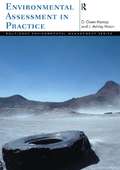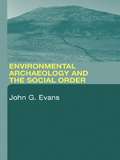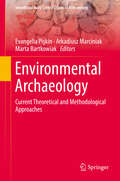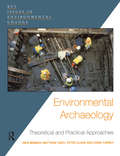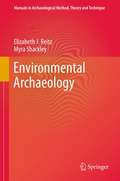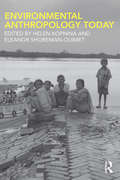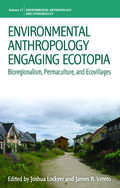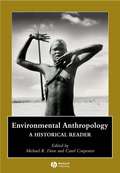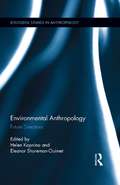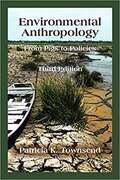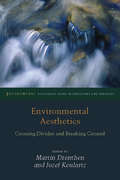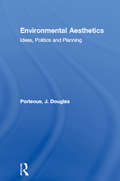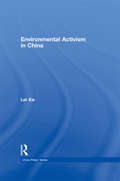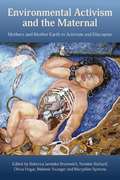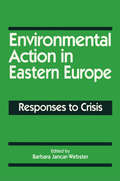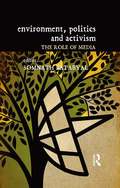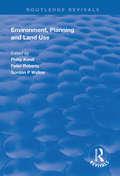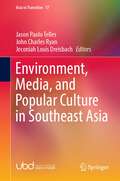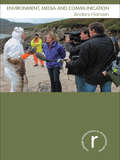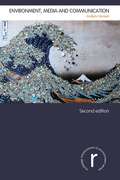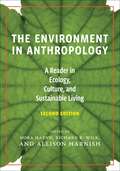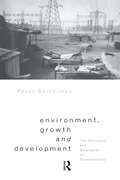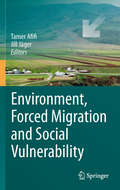- Table View
- List View
Environmental Assessment in Practice (Routledge Environmental Management)
by Owen Harrop Ashley NixonThis text explains what constitutes good practice in applying environmental assessment as an environmental management tool. A wide range of case studies and other student text features are employed to demonstrate how the different methods, techniques and disciplines of environmental assessment can be used. The authors address the key concepts for environmental assessment procedures: methods for using E.A.; techniques for impact prediction and evaluation; environmental risk assessment; EA consultation and participation; project management; environmental statement review and post-project analysis; and strategic environmental assessment.Worldwide case studies include: gas pipelines, hydroelectric power plants, gold mining, river crossings, waste-to-energy plants and gravel extraction in England, Scotland, Ireland, Canada, the USA, Venezuela, the Netherlands, Iceland, Zambia, Zimbabwe, South Africa and Ghana.
Environmental Archaeology and the Social Order
by John G. EvansPresenting a wide variety of case studies, ranging from the early Palaeolithic to Post-modernity, and from Europe to the Andes, West and East Africa, and the USA, Environmental Archaeology and the Social Order deals with both the theory and method of environmental archaeology. Including significant sections on Neanderthals, Palaeolithic mobiliary art and the origins of farming, as well as transhumance, climate as social construct, field survey and the place of documents in environmental research, Professor Evans interprets his findings in social constructionist terms, creating an important argument against the use of traditional materialist and processualist paradigms. This original and controversial volume sets a new agenda for the study and understanding of environmental archaeology, and will prove an informative and useful purchase.
Environmental Archaeology: Current Theoretical And Methodological Approaches (Interdisciplinary Contributions To Archaeology Ser.)
by Marta Bartkowiak Arkadiusz Marciniak Evangelia PişkinThis book aims to thoroughly discuss new directions of thinking in the arena of environmental archaeology and test them by presenting new practical applications.Recent theoretical and epistemological advancement in the field of archaeology calls for a re-definition of the subdiscipline of environmental archaeology and its position within the practise of archaeology. New technological and methodological discoveries in hard sciences and computer applications opened fresh ways for interdisciplinary collaborations thus introducing new branches and specialisations that need now to be accommodated and integrated within the previous status-quo.This edited volume will take the challenge and engage with contemporary international discussions about the role of the discipline within the general framework of archaeology. By drawing upon these debates, the contributors to this volume will rethink what environmental archaeology is and what kind of input the investigation of this kind of materiality has to the reconstruction of human history and sociality.
Environmental Archaeology: Theoretical and Practical Approaches (Key Issues in Environmental Change)
by Peter Clark Chris Turney Matthew Canti Nick BranchEnvironmental Archaeology: Theoretical and Practical Approaches outlines and assesses the various methods used to reconstruct and explain the past interaction between people and their environment. Emphasising the importance of a highly scientific approach to the subject, the book combines geoarchaeological, bioarchaeological (archaeobotany and zooarchaeology) and geochronological information and examines how these various aspects of archaeology may be used to enhance our knowledge and understanding of past human environments. Drawing from both the practical experiences of the authors and cutting-edge research, Environmental Archaeology: Theoretical and Practical Approaches is a valuable contribution to the subject. It will be essential reading for students and professionals in archaeology, geography and anthropology.
Environmental Archaeology
by Myra Shackley Elizabeth ReitzOne of the most significant developments in archaeology in recent years is the emergence of its environmental branch: the study of humans' interactions with their natural surroundings over long periods, and of organic remains instead of the artifacts and household items generally associated with sites. With the current attention paid to human responsibility for environmental change, this innovative field is recognized by scientists, conservation and heritage managers, and policymakers worldwide. In this context comes Environmental Archaeology by Elizabeth Reitz and Myra Shackley, updating the seminal 1981 text Environmental Archaeology by Myra Shackley. Rigorously detailed yet concise and accessible, this volume surveys the complex and technical field of environmental archaeology for researchers interested in the causes, consequences, and potential future impact of environmental change and archaeology. Its coverage acknowledges the multiple disciplines involved in the field, expanding the possibilities for using environmental data from archaeological sites in enriching related disciplines and improving communication among them. Introductory chapters explain the processes involved in the formation of sites, introduce research designs and field methods, and walk the reader through biological classifications before focusing on the various levels of biotic and abiotic materials found at sites, including:Sediments and soils.Viruses, bacteria, archaea, protists, and fungi.Bryophytes and vascular plants. Wood, charcoal, stems, leaves, and roots. Spores, pollen, and other microbotanical remains. Arthropods, molluscs, echinoderms, and vertebrates. Stable isotopes, elements, and biomolecules.The updated Environmental Archaeology is a major addition to the resource library of archaeologists, environmentalists, historians, researchers, policymakers--anyone involved in studying, managing, or preserving historical sites. The updated Environmental Archaeology is a major addition to the resource library of archaeologists, environmentalists, historians, researchers, policymakers--anyone involved in studying, managing, or preserving historical sites
Environmental Anthropology Today
by Helen Kopnina Eleanor Shoreman-OuimetToday, we face some of the greatest environmental challenges in global history. Understanding the damage being done and the varied ethics and efforts contributing to its repair is of vital importance. This volume poses the question: What can increasing the emphasis on the environment in environmental anthropology, along with the science of its problems and the theoretical and methodological tools of anthropological practice, do to aid conservation efforts, policy initiatives, and our overall understanding of how to survive as citizens of the planet? Environmental Anthropology Today combines a range of new ethnographic work with chapters exploring key theoretical and methodological issues, and draws on disciplines such as sociology and environmental science as well as anthropology to illuminate those issues. The case studies include work on North America, Europe, India, Africa, Asia, and South America, offering the reader a stimulating and thoughtful survey of the work currently being conducted in the field.
Environmental Anthropology Engaging Ecotopia
by Joshua Lockyer James R. VetetoIn order to move global society towards a sustainable "ecotopia," solutions must be engaged in specific places and communities, and the authors here argue for re-orienting environmental anthropology from a problem-oriented towards a solutions-focused endeavor. Using case studies from around the world, the contributors-scholar-activists and activist-practitioners- examine the interrelationships between three prominent environmental social movements: bioregionalism, a worldview and political ecology that grounds environmental action and experience; permaculture, a design science for putting the bioregional vision into action; and ecovillages, the ever-dynamic settings for creating sustainable local cultures.
Environmental Anthropology: A Historical Reader
by Michael R. Dove Carol CarpenterEnvironmental Anthropology: A Reader is a collection of historically significant readings, dating from early in the twentieth century up to the present, on the cross-cultural study of relations between people and their environment. Provides the historical perspective that is typically missing from recent work in environmental anthropology Includes an extensive intellectual history and commentary by the volume's editors Offers a unique perspective on current interest in cross-cultural environmental relations Divided into five thematic sections: (1) the nature/culture divide; (2) relationship between environment and social organization; (3) methodological debates and innovations; (4) politics and practice; and (5) epistemological issues of environmental anthropology Organized into a series of paired papers, which 'speak' to each other, designed to encourage readers to make connections that they might not customarily make
Environmental Anthropology: Future Directions (Routledge Studies in Anthropology #11)
by Helen Kopnina Eleanor Shoreman-OuimetThis volume presents new theoretical approaches, methodologies, subject pools, and topics in the field of environmental anthropology. Environmental anthropologists are increasingly focusing on self-reflection - not just on themselves and their impacts on environmental research, but also on the reflexive qualities of their subjects, and the extent to which these individuals are questioning their own environmental behavior. Here, contributors confront the very notion of "natural resources" in granting non-human species their subjectivity and arguing for deeper understanding of "nature," and "wilderness" beyond the label of "ecosystem services." By engaging in interdisciplinary efforts, these anthropologists present new ways for their colleagues, subjects, peers and communities to understand the causes of, and alternatives to environmental destruction. This book demonstrates that environmental anthropology has moved beyond the construction of rural, small group theory, entering into a mode of solution-based methodologies and interdisciplinary theories for understanding human-environmental interactions. It is focused on post-rural existence, health and environmental risk assessment, on the realm of alternative actions, and emphasizes the necessary steps towards preventing environmental crisis.
Environmental Anthropology: From Pigs to Policies
by Patricia K. TownsendEnvironmental anthropologists organize the realities of interdependent lands, plants, animals, and human beings; advocate for the neediest among them; and provide guidance for conservation efforts. But can anthropologists' studies of small-scale systems contribute to policies that address profoundly interconnected global problems? Townsend explores this question in her concise introduction to environmental anthropology. <p><p> While maintaining the structure and clarity of previous editions, the third edition has been thoroughly revised to include new research. Newly added are a chapter on the environmental impact of war and recommended readings and films. Townsend begins with a historical overview of the field, illustrating how earlier ideas and approaches help to understand how today's populations adapt to their physical and biological environments. She then transitions to a closer look at global environmental issues, including such topics as rapid expansion of the world economic system and inequality, loss of biodiversity and its implications for human health, and injustices of climate change, resource extraction, and toxic waste disposal. The final chapters caution that meaningful change requires social movements and policy changes in addition to individual actions.
Environmental Aesthetics: Crossing Divides and Breaking Ground
by Martin Drenthen Jozef KeulartzEnvironmental aesthetics crosses several commonly recognized divides: between analytic and continental philosophy, Eastern and Western traditions, universalizing and historicizing approaches, and theoretical and practical concerns. This volume sets out to show how these,perspectives can be brought into conversation with one another. The first part surveys the development of the field and discusses some important future directions. The second part explains how widening the scope of environmental aesthetics demands a continual rethinking of the relationship between aesthetics and other fields. How does environmental aesthetics relate to ethics? Does aesthetic appreciation of the environment entail an attitude of respect? What is the relationship between the theory and practice? The third part is devoted to the relationship between the aesthetics of nature and the aesthetics of art. Can art help “save the Earth”? The final part illustrates the emergence of practical applications from theoretical studies by focusing on concrete case studies.
Environmental Aesthetics: Ideas, Politics and Planning
by J. Douglas PorteousEnvironmental Aesthetics is a comprehensive introduction. It includes a history of aesthetics, discussing the psychology of human-environment relations, and artistic influences on the city and analysing the roles of policy and planning.
Environmental Activism in China (China Policy Series #Vol. 9)
by Lei XieMajor environmental degradation is a serious problem for China as the country's economy continues to grow at a phenomenal pace. In recent years environmental organisations have begun to emerge in China, and in some cases have had remarkable success in affecting policies which would have had significant adverse impacts on the environment. This book, based on extensive original research, adopts a multi-disciplinary research approach to examine environmental activism in China, focusing on four cities. It analyses the nature, characteristics, strategies, organizational modes and influence of what could be labeled a Chinese environmental movement in-the-making. In particular, this volume highlights the specificities of Chinese environmental activism in an increasingly globalizing world, along with a comparison to the environmental movement in Western Europe and North America.
Environmental Activism and the Maternal: Mothers And Mother Earth In Activism And Discourse
by Rebecca Jaremko Bromwich Noemie Richard Olivia Ungar Melanie Younger Maryellen SymonsThis anthology seeks to explore the complex, varied, and sometimes contradictory intersections between mothers, mothering, and environmental activism in discourse and in lived experiences. It is intended to look critically, and yet hopefully, at the ways in which feminist, Indigenous, and environmentalist challenges to the western, capitalist moral imagination are linked. It explores the reach of rape culture and the ways in which a capitalist, patriarchal society interacts with the earth as a feminine-personified identity. It also shares the hope available to all women through raising a coming generation and the great power to effect change. This work endeavours to share lessons from the Earth in resistance to the continued assaults of anthropogenic capitalist industry, and to inspire new ways to course-correct, to resist, to rise up, to create differently, and to foster evolution and revolution as mothers, as women, and as hearts and minds. This volume is curated to be a space for critical discussion about representations linking environmental activism, maternality, and "mother earth," as well as a venue for creative expression and art. In keeping with its intention to provide a space for discussion of a complex and varied array of perspectives on mothers, mothering, and mother earth, this is an interdisciplinary anthology. Contributions included hail from a wide range of disciplines and fields including psychology, sociology, anthropology, women's and gender studies, cultural studies, literary studies, as well as law and legal studies. Contributions from scholars working in the fields of social science are interwoven with creative contributions from academics, writers, and artists working in fields in the humanities.
Environmental Action in Eastern Europe: Responses to Crisis
by Barbara Jancar-WebsterThe environmental crisis in Eastern Europe - air and water pollution, toxic waste dumps, and unsafe nuclear facilities - has been vividly documented since the revolution of 1989. Not only did the communist states have an abysmal record of environmental destruction, but the issue of environmental protection and safety proved to be one of the msot powerful catalysts of unified opposition to these regimes. This collection of essays by both Western and East European experts examines the efforts to develop strategies for dealing with the crisis, both by governments and at the grassroots level of newly emerging Green movements. Among the countries represented here are Poland, Hungary, Czechoslovakia, Lithuania, Slovenia and the Commonwealth of Independent States.
Environment, Politics and Activism: The Role of Media
by Somnath BatabyalThis book examines the role of the media in environmental politics and activism in the 21st century. It highlights how politics is mediated in myriad ways through newspapers and news channels, through mobile telephony and through social networking sites. Further, it shows how the media creates and influences relevant discourses, builds campaigns and awareness, and adopts and discards issues. With a range of perspectives on issues of environmental justice and equity, the volume scrutinizes how the media discourse on environment shapes our politics, and the role of international politics, finance, youth, newspapers, magazines and 24-hour television. Bringing together academics, activists and media persons, this highly topical book will serve as significant reading for researchers and scholars of development studies and media studies, as well as policymakers, NGOs and environmental campaigners.
Environment, Planning and Land Use (Routledge Revivals)
by Philip Kivell Peter Roberts Gordon P. WalkerPublished in 1998, this work focuses on the practical issues and policies relating to planning and managing both built and natural environments. It addresses the needs to pursue a greater degree of integration between the subject matter and the international frameworks of environmental planning.
Environment, Media, and Popular Culture in Southeast Asia (Asia in Transition #17)
by Jason Paolo Telles John Charles Ryan Jeconiah Louis DreisbachThis book addresses the increasingly important subject of ecomedia by critically examining the interconnections between environment, ecology, media forms, and popular culture in the Southeast Asian region, exploring methods such as textual analysis, thematic analysis, content analysis, participatory ethnography, auto ethnography, and semi-structured interviewing. It is divided into four sections: I. Activism, Environment, and Indigeneity; II. Political, Ecologies and Urban Spaces; III. Narratives, Discourses, and Aesthetics; and IV. Imperialism, Nationalism, and Islands, covering topics such as broadcast media (radio and TV) and the environment; green cinema and ecodocumentaries, ecodigital art, digital environmental literature. It is of great interest to researchers, students, practitioners and scholars working in the area of humanities, media, communications, cultural studies, environmental humanities, environmental studies, and sustainability.
Environment, Media and Communication
by Anders HansenCommunication about ‘the environment’ in and through a broad array of news, advertising, art and entertainment media is one of the major sources of public and political understanding of definitions, issues and problems associated with the environment. Environment, Media and Communication examines the social, cultural and political roles of the media as a public arena for images, representations, definitions and controversy regarding the environment. The book starts by discussing and outlining a framework for analyzing media and communication roles in the emergence of the environment and environmental problems as issues for public and political concern. It proceeds to examine who and what drives the public agenda on environmental issues, addressing questions about how governments, scientists, experts, pressure groups and other stakeholders have sought to use traditional as well as newer media for promoting their definitions of the key issues. The media are not merely an open public arena or stage, but rather themselves a key gate-keeper and influence in the process of communicating about the environment: the role of news values, organizational arrangements and professional practices, are thus examined next. Recognizing the importance of wider popular culture narratives to public understanding and communication about the environment and nature, the book proceeds with a discussion of the messages and moral tales communicated about the environment, science and nature in a range of media, including film and advertising media. It shows how this wider context provides important clues to understanding the successes and failures of selected environmental issues or campaigns. The book finishes with an examination of the key approaches and models used for understanding how the media influence and interact with public opinion and political decision-making on environmental issues. Offering a comprehensive introduction to theoretical approaches and models for the study of media and communication roles regarding the environment, and drawing on empirical research evidence and examples from Europe, America, Australia and Asia, the book will be of interest to students in media/communication studies, geography, environmental studies, political science and sociology as wll as to environmental professionals and activists.
Environment, Media and Communication (Routledge Introductions to Environment: Environment and Society Texts)
by Anders HansenMedia and communication processes are central to how we come to know about and make sense of our environment and to the ways in which environmental concerns are generated, elaborated, manipulated and contested. The second edition of Environment, Media and Communication builds on the first edition’s framework for analysing and understanding media and communication roles in the politics of the environment. It draws on the significant and continuing growth and advances in the field of environmental communication research to show the increasing diversification and complexity of environmental communication. The book highlights the persistent urgency of analysing and understanding how communication about the environment is being influenced and manipulated, with implications for how and indeed whether environmental challenges are being addressed and dealt with. Since the first edition, changes in media organisations, news media and environmental journalism have continued apace, but – perhaps more significantly – the media technologies and the media and communications landscape have evolved profoundly with the continued rise of digital and social media. Such changes have gone hand in hand with, and often facilitated, enabled and enhanced shifting balances of power in the politics of the environment. There is thus a greater need than ever to analyse and understand the roles of mediated public communication about the environment, and to ask critical questions about who/what benefits and who/what is adversely affected by such processes. This book will be of interest to students in media/communication studies, geography, environmental studies, political science and sociology as well as to environmental professionals and activists.
Environment in the Balance
by Jonathan Z. CannonDoes the green movement remain a transformative force in American life? In Environment in the Balance Jonathan Cannon interprets a wide range of U.S. Supreme Court decisions over four decades and explores the current ferment among activists, to gauge the practical and cultural impact of environmentalism and its future prospects.
The Environment in Anthropology (Second Edition): A Reader in Ecology, Culture, and Sustainable Living
by Nora Haenn Richard Wilk Allison HarnishThe Environment in Anthropology presents ecology and current environmental studies from an anthropological point of view. From the classics to the most current scholarship, this text connects the theory and practice in environment and anthropology, providing readers with a strong intellectual foundation as well as offering practical tools for solving environmental problems. Haenn, Wilk, and Harnish pose the most urgent questions of environmental protection: How are environmental problems mediated by cultural values? What are the environmental effects of urbanization? When do environmentalists' goals and actions conflict with those of indigenous peoples? How can we assess the impact of "environmentally correct" businesses? They also cover the fundamental topics of population growth, large scale development, biodiversity conservation, sustainable environmental management, indigenous groups, consumption, and globalization. This revised edition addresses new topics such as water, toxic waste, neoliberalism, environmental history, environmental activism, and REDD (Reducing Emissions from Deforestation and Forest Degradation), and it situates anthropology in the multi-disciplinary field of environmental research. It also offers readers a guide for developing their own plan for environmental action. This volume offers an introduction to the breadth of ecological and environmental anthropology as well as to its historical trends and current developments. Balancing landmark essays with cutting-edge scholarship, bridging theory and practice, and offering suggestions for further reading and new directions for research, The Environment in Anthropology continues to provide the ideal introduction to a burgeoning field.
The Environment in Anthropology
by Nora Haenn Richard WilkThe Environment in Anthropology presents ecology and current environmental studies from an anthropological point of view. From the classics to the most current scholarship, this book connects the theory and practice in environment and anthropology, giving readers a strong intellectual foundation as well as offering practical tools for solving environmental problems.Haenn and Wilk pose the most urgent questions of environmental protection: How are environmental problems mediated by cultural values? What are the environmental effects of urbanization? When do environmentalists get in conflict with indigenous peoples? How can we assess the impact of "environmentally correct" businesses such as the Body Shop? They also cover the fundamental topics of population growth, large scale development, biodiversity conservation, sustainable environmental management, indigenous groups, consumption, and globalization.Balancing landmark essays with cutting-edge scholarship, bridging theory and practice, and offering suggestions for further reading and new directions for research, The Environment in Anthropology is the ideal introduction to a burgeoning field.Contributors include: J. Peter Brosius, Billie DeWalt, Arturo Escobar, Akhil Gupta, Caren Kaplan, Conrad Kottak, David Maybury-Lewis, B.J. McCay, Kay Milton, Virginia Nazarea, Robert Netting, Vandana Shiva, Julian Steward, and Susan C. Stonich.
Environment, Growth and Development: The Concepts and Strategies of Sustainability
by Peter BartelmusFirst Published in 2004. Environment, Growth and Development offers a unique analysis of sustainable economic growth and development and the implications for policy and planning at the local, national and global scale.
Environment, Forced Migration and Social Vulnerability
by Tamer Afifi Jill JägerThis book examines the linkages between environmental change and forced migration. This has been a headline topic during the past few years with predictions of "millions of refugees". It presents case studies from across the world of responses to climate change as well as other environmental changes and examines the role that environmental change plays among the other factors that lead to a decision to migrate.
